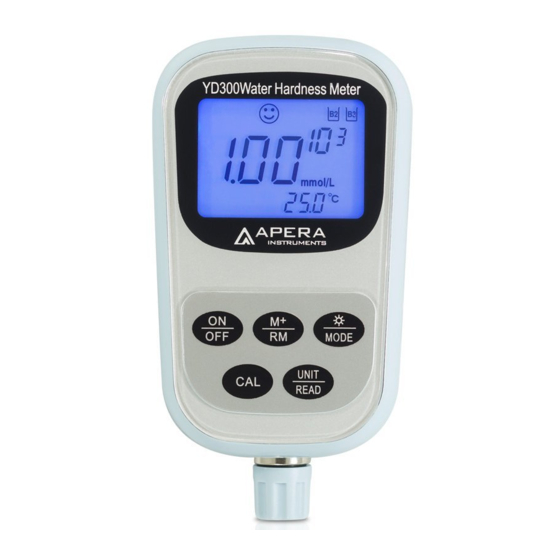Summary of Contents for Apera Instruments YD300
- Page 1 YD300 Portable Water Hardness Meter Instruction Manual Apera Instruments, LLC www.aperainst.com...
-
Page 2: Table Of Contents
Table of Contents 1. Brief Introduction ............................... 2 Features..................................2 2. Technical Specifications............................. 3 2.1. Units of Water Hardness and their Conversions ....................3 2.2. Technical Parameters ............................4 3. Meter Instructions ..............................5 3.1. LCD Display ............................... 5 3.2. Keypad................................. 6 4. -
Page 3: Brief Introduction
For technical support, please contact us at info@aperainst.com or +1 (614)-285-3080. Apera Instruments reserves the right to update the content of this manual without giving prior notices. We call the total concentration of calcium ion (Ca2 ) and magnesium ion (Mg2 ) in water sample to be the hardness of water. -
Page 4: Technical Specifications
2. Technical Specifications 2.1. Units of Water Hardness and their Conversions mmol/L —basic unit for water hardness mg/L (CaCO ) — water hardness based on quality concentration of CaCO also known as ppm and U.S. Degree. mg/L (CaO) —water hardness based on quality concentration of CaO mmol/L (Boiler) —... -
Page 5: Technical Parameters
2.2. Technical Parameters 2.2.1. Water Hardness (0 ~ 10)mmol/L; (0 ~ 401)mg/L(Ca); (0 ~ 1000)mg/L(CaCO ); (0 ~ 100)ºfH(France Degree); (0 ~ 561)mg/L(CaO); (0 ~ 56)ºdH(German Degree); Measuring range (0 ~ 20)mmol/L(Boiler); (0 ~ 70)ºeH (England Degree)。 Resolution 0.01 and 0.1 water hardness units ±5% FS Accuracy (5 - 50℃)... -
Page 6: Meter Instructions
2.2.4. Working conditions Ambient Temperature 5-35℃ (41-95ºF) Ambient Humidity ≤85% IP Grade IP57 Waterproof and Dustproof 3. Meter Instructions 3.1. LCD Display ① — Measuring Water Hardness reading; adopts a modular form to express, such as means 2.00×10 ② — Measuring units; appears by following order: mmol/L, mg/L(CaCO ), mg/L(CaO), mmol/L(Boiler), ºfH , ºdH , ºeH and mg/L(Ca). -
Page 7: Keypad
3.2. Keypad This meter has a total of five operating keys. Power button Button to control backlight; short press this button to turn on backlight, Long Press this button (press time > 2 seconds) to enter parameter setting mode Calibration button, press this button to enter meter’s calibration mode. Button for unit switch and confirmation, when in measuring mode, press the button to change measurement unit;... -
Page 8: Considerations During Measurement Preparations
4.2. Considerations During Measurement Preparations When using, shake the electrode with force to make the inner solution of electrode into the 4.2.1. compartment of measuring head. There shouldn’t be any bubbles present in the measuring head. When soaking or calibrating electrode, the test cup should be placed in the black base to avoid 4.2.2. -
Page 9: Notes In Meter's Calibration
it into the B2 solution, stir for a few seconds and let it stand still; take reading after appears and stays; The reading should be equal or less than 2.00 ±0.25×10 mmol/L. Otherwise, please repeat the calibration process (section 4.3.1 to 4.3.3). 4.4. -
Page 10: Notes During Sample Test
4.6. Notes during Sample Test Electrode must be rinsed thoroughly with distilled/deionized water before measuring. The 4.6.1. container for diluted and concentrated solutions should be separated. When testing, try to test diluted solution first and then test concentrated solution. Generally, calibration is necessary before every test, but if interval between tests is short, then 4.6.2. -
Page 11: Meter's Parameter Settings
5. Meter’s Parameter Settings 5.1. Parameter Setting Table Prompt Parameter setting items Parameter -------- Calibration Method Setting Resolution Setting 0.01-0.1 ℃-℉ Temperature Unit Setting Activity Compensation Setting OFF-On Automatic Backlight Setting OFF-On Automatic Power Off OFF-On Default Setting OFF-On 5.2. Calibration Method Setting (P1) Press button (>... -
Page 12: Temperature Units Setting (P3)
5.4. Temperature Units Setting (P3) Press button under the P2 setting, meter enters temperature unit setting state P3. LCD display as in picture (5- 3), press button to change temperature units between °C and °F, press button to confirm and return to measuring mode;... -
Page 13: On/Off Setting Of Restore To Default Setting (P7)
the default setting is ON. When choosing ON, the automatic power off function is activated; the meter will power off automatically after 10 minutes if no operation; when choosing OFF, means automatic power off function is cancelled. 5.8. ON/OFF Setting of Restore to Default Setting (P7) Short press button under the P6 setting, meter enters ON/OFF setting of restoring to default setting P7. -
Page 14: Recall Measuring Data
7. Meter’s Complete Kit 1set 7.1. Model YD300 water hardness meter 7.2. Model 601-S water hardness electrode 2pcs 7.3. AA cell (1.5V ) (installed) 1btl/each 7.4. -
Page 15: Additional Accessories
We warrant this instrument to be free from defects in material and workmanship and agree to repair or replace free of charge, at option of APERA INSTRUMENTS, LLC, any malfunctioned or damaged product attributable to responsibility of APERA INSTRUMENTS, LLC for a period of TWO YEARS (SIX MONTHS for the water hardness electrode) from the delivery. - Page 16 See 4.6.5. turbid and white Membrane becomes Negative pressure within Loosen the measuring head and See 4.6.6. concave the electrode tighten it again. APERA INSTRUMENTS, LLC Address: 6656 Busch Blvd, Columbus Ohio 43229 Tel: 1-614-285-3080 Email: info@aperainst.com Website: www.aperainst.com V1.1...


















Need help?
Do you have a question about the YD300 and is the answer not in the manual?
Questions and answers